In this article, you will learn what an IVF timeline looks like.
From the day you have your first consultation to the day you leave with a pregnancy.
Let’s get started.
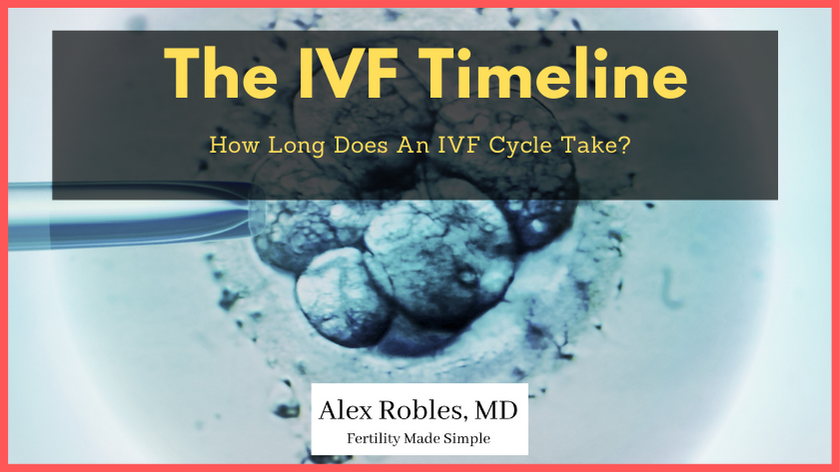
How long is the IVF process from start to finish?
Ann IVF cycle lasts approximately two weeks from the time you start your injections to when you have your eggs retrieved. A fresh embryo transfer can happen five days after the retrieval.
In contrast, a frozen embryo transfer can occur no earlier than four weeks after your retrieval.
That’s the general timeline. Now let’s break it down step-by-step.
What is the IVF process step by step? (The IVF Timeline)
An IVF treatment cycle has three distinct phases:
- Phase 1: Preparing for the IVF cycle
- Phase 2: The IVF cycle
- Phase 3: The Embryo Transfer
Phase 1: IVF Prep-work
Step 1: Initial Consultation (Day 1)
The first step in the fertility treatment process is the initial consultation with a reproductive endocrinologist.
During this office visit, you will discuss your medical history and have a physical exam. A transvaginal ultrasound may also be performed.
Step 2: The Fertility Work-up (Day 2-30)
Next, your doctor will order several tests to look for a possible cause of your infertility. These tests vary depending on your age, medical history, and personal preferences.
Testing includes:
- Baseline hormones and ovarian reserve (AMH)
- A uterine / cavity evaluation (hysterosalpingogram, saline infusion sonogram, or hysteroscopy)
- Other blood tests, including thyroid function and other essential health markers
All testing can take up to 30 days or more to complete.
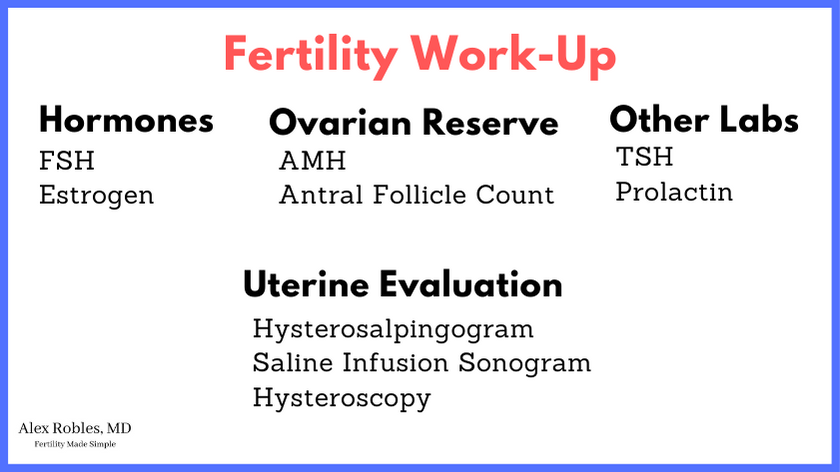
Step 3: The Follow-Up Consultation (~Day 35)
Once the testing is complete, you will return to your doctor’s office for a follow-up.
You and your doctor will review the results of your tests and discuss your treatment options.
If you both agree to IVF, you will return to the office on Day 2-3 of your next menstrual cycle to start the injections.
(*Note: Sometimes, your doctor may put you on oral contraceptives, aka birth control pills, to expedite this process).
Phase 2: The IVF Cycle
Step 4: Ovarian Stimulation (Day 2-3)
The IVF cycle starts with you coming in on Day 2-3 of your menstrual cycle to have a baseline ultrasound and blood work done.
If all looks good with your ultrasound and hormone levels, you will begin your injections that night.
Generally, you will inject yourself once daily with two different medications.
Step 5: Monitoring Ultrasounds (Days ~5-14)
Once you begin your injections, you will have transvaginal ultrasounds every 1-3 days.
The purpose of these ultrasounds is to check on the progress of your follicles.
You will also have blood tests to check your estrogen levels, LH, and progesterone levels during this time.
On average, most cycles will require 8-12 days of injections before you take your trigger shot.
Step 6: Egg Retrieval (Day ~14-16)
The egg retrieval is then performed ~36 hours after the trigger shot. It is a simple procedure done under light anesthesia and only takes about 15 minutes to complete.
A transvaginal ultrasound is used to guide a needle into each of your ovaries. The fluid in each follicle is aspirated and collected into a tiny tube.
Your doctor may also do a mock embryo transfer at this time to assess the size and shape of your uterine cavity.
The tube is then handed to an embryologist who searches for the eggs under a microscope.
Step 7: Fertilization (Day 0-1 After Retrieval)
The embryologist will then take your preferred semen sample to fertilize your mature eggs.
There are two methods of fertilization.
- Conventional insemination (placing them on a petri dish with millions of sperm) or
- Intracytoplasmic Sperm Injection aka ICSI (injecting a single sperm into the egg)

The embryologist then checks for successful fertilization the next day (~18 hours after ICSI or insemination).
Immature eggs are usually discarded as these are not viable eggs.
Step 8: Embryo Development (Days 3-7 After Retrieval)
The successfully fertilized eggs will then be left in an incubator to grow and divide.
Phase 3: The Embryo Transfer
Step 9: The Fresh Embryo Transfer (Day 3 or Day 5 After Retrieval)
If you are having a fresh Day 3 embryo transfer, it will occur three days after the egg retrieval.
If you are growing your embryos to the blastocyst stage, they are watched until Days 5, 6, or 7.
Usually, only an embryo that has made it to the blastocyst stage by Day 5 would be transferred on Day 5. If no embryos have made it blast by Day 5, then your fresh transfer will likely be canceled.
The embryo transfer procedure is pretty painless and usually straightforward.
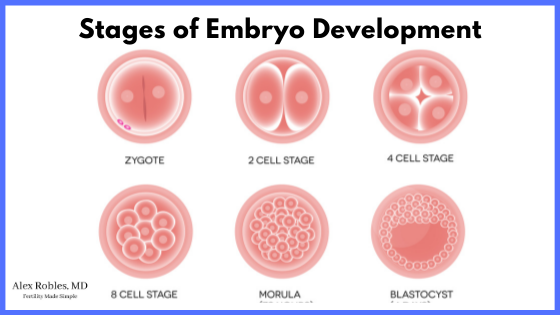
Step 10: Freezing Embryos (Days 5, 6, and 7 After Retrieval)
Any extra embryos that make it to the blast stage on Days 5, 6, or 7 will be frozen (aka vitrified).
The embryos can remain frozen indefinitely for future use.
*Of note, an embryo biopsy can also be performed before freezing to look for any chromosomal abnormalities. This is known as preimplantation genetic testing.
Step 11: The Frozen Embryo Transfer (At Any Time)
If you do not have a fresh transfer, you will do a frozen embryo transfer (FET) cycle.
Depending on your preferences, you may be able to start the cycle right away with your next period or at any time in the future.
A FET cycle also begins on Days 2 or 3 of your menstrual cycle.
Depending on the type of cycle you are doing (medicated cycle vs. natural cycle), you will have your transfer ~3 weeks later.
Step 12: The Pregnancy Test
The last step is a pregnancy blood test ~9-14 days after a blastocyst embryo transfer. If your test is positive, you will be approximately four weeks pregnant!
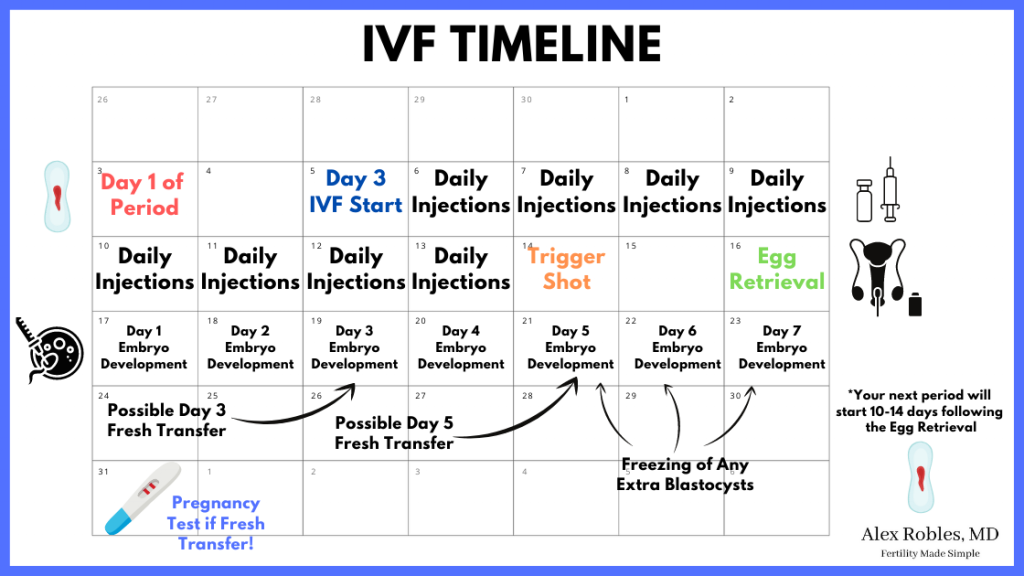
To sum it up:
So, the entire process can take as little as four weeks from the start of injections to the first pregnancy test.
If you decide on a frozen embryo transfer, you can expect an additional 4+ weeks from the start of the transfer cycle to your first pregnancy test.
Other Related Questions
How many rounds of IVF does it usually take to see success? (Typical IVF success rates)
Each individual IVF cycle has a success rate of about 30-50% in patients between 30-37 years of age.
In general, the more eggs collected per cycle, the higher the likelihood of success.
Success is defined as having a live birth.
As such, one to two cycles of IVF might be sufficient for patients between 30-37.
However, the success rate per cycle decreases with age, and some patients may need multiple rounds.
How many days do you take IVF injections for?
In general, most patients will need to take IVF injections for 8-12 days. The trigger shot is then administered on the last day before the egg retrieval.
What day of your cycle do you start IVF injections?
Most patients start IVF injections on Day 2 or Day 3 of the menstrual cycle.
Occasionally, some patients can have a random start (i.e., starting on any day of the cycle) if they need to do a cycle emergently.
If you start in the early follicular phase (Day 2 or 3), you will need to come in for an ultrasound and blood tests to ensure optimal timing.
What does a typical IVF injection schedule look like?
Most patients will start giving themselves daily injections from Day 2 or Day 3 of their menstrual cycle.
Usually, you will start with two injections nightly.
These usually include:
- FSH (Gonal-F or Follistim)
- and FSH and LH (Menopur)
A third injection (the antagonist) is then started around Days 5-6 of the stimulation. You will continue these three injections nightly until the trigger shot.
The trigger shot (a purified form of human chorionic gonadotropin hormone) is taken on or before Day 12 of stimulation.
Is IVF painful?
However, the egg retrieval procedure can be more uncomfortable. The amount of cramping and discomfort you feel is directly related to the number of eggs retrieved.
The good news is, most patients are back to their daily activities within 24 hours.
*Note: Ovarian hyperstimulation syndrome is a rare complication of IVF that can lead to pain, nausea, and bloating for several days following the procedure.
How long does it take for an IVF embryo to attach to the uterine lining?
An embryo transferred at the blastocyst stage will implant in the first 24-48 hours. However, it won’t begin secreting pregnancy hormone until several days later.
We often recommend that you wait at least 9-10 days before checking your first pregnancy test.
At what stage are embryos transferred in IVF?
Blastocyst stage embryos tend to have higher success rates than Day 3 embryos when it comes to
- implantation rates
- pregnancy rates
- and live birth rates
A blastocyst is more likely to be a viable embryo as it has already proven itself in the laboratory.
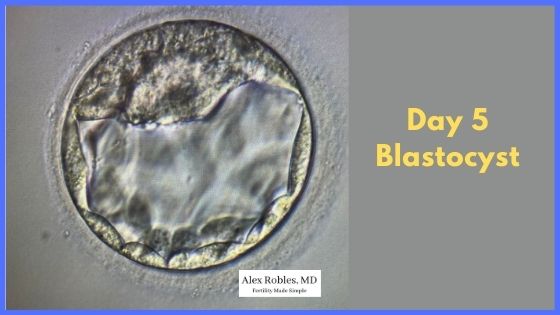
With that said, not every patient can make blastocysts and will elect to transfer at Day 3.
Conclusion
All types of fertility treatments typically follow the trend of your menstrual cycle, with the average IVF cycle lasting about two weeks.
The entire in vitro fertilization process can be as short as four weeks if you are fortunate enough to make healthy embryos right away.
However, it can take several years, depending on how many cycles it takes to achieve a healthy pregnancy.
If you ever have any questions, don’t hesitate to reach out to a fertility specialist!
Related Articles:
- Is IVF Painful? The Honest Truth
- IVF Medication Side Effects? Are They Serious?
- IVF vs IUI: When Should You Do One Over The Other?
Make An Appointment With Dr. Robles To Discuss Your Fertility Options Today!
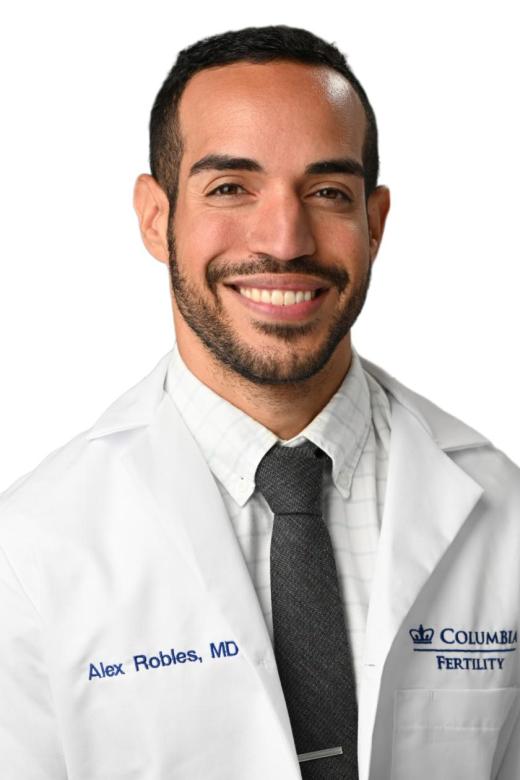
Alex Robles, MD
Dr. Alex Robles is a Spanish-speaking Latino-American Reproductive Endocrinologist and Infertility specialist in New York City, and a board-certified OBGYN. He has a special interest in health, lifestyle, & nutrition. Make an appointment with Dr. Robles to discuss your fertility options today!
References:
- Smith ADAC, Tilling K, Nelson SM, Lawlor DA. Live-Birth Rate Associated With Repeat In Vitro Fertilization Treatment Cycles. JAMA. 2015;314(24):2654-2662. doi:10.1001/jama.2015.17296
- Kim SM, Kim JS. A Review of Mechanisms of Implantation. Dev Reprod. 2017;21(4):351-359. doi:10.12717/DR.2017.21.4.351
- Kontopoulos G, Simopoulou M, Zervomanolakis I, et al. Cleavage Stage versus Blastocyst Stage Embryo Transfer in Oocyte Donation Cycles. Medicina (Kaunas). 2019;55(6):293. Published 2019 Jun 20. doi:10.3390/medicina55060293
